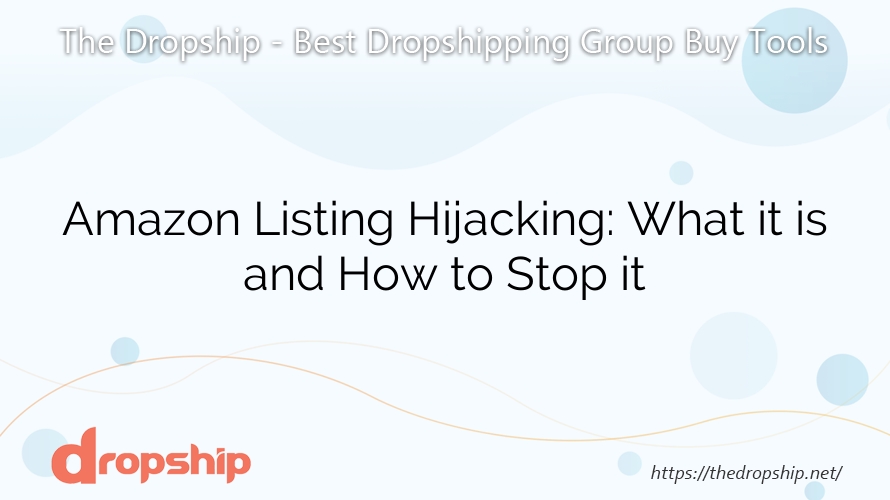Dropshipping
Amazon Listing Hijacking: What it is and How to Stop it
Amazon is one of the most popular e-commerce platforms globally, with millions of sellers and buyers. However, it is not without its challenges. One of the most significant issues that Amazon sellers face is listing hijacking. This can be a devastating experience for any seller as it negatively impacts their brand reputation, sales, and revenue. In this article, we will explore what Amazon listing hijacking is and how you can prevent it from happening to your listings.
What is Amazon Listing Hijacking?
Amazon listing hijacking refers to unauthorized third-party sellers taking control of an existing product listing and selling counterfeit or inferior quality products under the same listing. The hijacker can change the item description, images, and pricing, among other vital details. The hijackers exploit the established product listing’s credibility and reputation to sell their products illegally.

Examples and real-life scenarios:
- A seller creates a new product listing on Amazon and invests time, effort, and money in optimizing it. After a few months, the listing becomes successful, generating high traffic and sales. Suddenly, another seller takes control of the listing and starts selling counterfeit products under the same listing, causing the original seller to lose sales and revenue.
- A hijacker alters a seller’s product listing by modifying the product title, introducing inaccurate information, and adding irrelevant keywords. As a result, the listing’s search ranking drops, leading to lower visibility, traffic, and sales.
The Motives Behind Amazon Listing Hijacking
There are various reasons why hijackers target Amazon listings. Some of the motives include:
- Financial gain: Hijackers can make significant profits by selling counterfeit or low-quality products under established listings. They take advantage of the high traffic and sales generated by reputable listings to drive sales for their goods.
- Competitive Advantage: Competitors may hijack an established product listing to eliminate competition. They alter the item description, pricing, and other details to make the products less appealing to potential buyers.
- Malicious intent: Some hijackers are motivated by malicious intent and seek to sabotage a seller’s business. They may intentionally damage the product, leave fake negative reviews, or alter the listing’s content to mislead customers.
Types of Amazon Listing Hijacking

- Counterfeit Hijacking
Counterfeit hijacking occurs when a third-party seller hijacks an established product listing on Amazon and sells counterfeit goods under it. The hijacker may use the original product images, descriptions, and even pricing to deceive customers into buying their inferior products.
How to identify and combat counterfeit hijackers:
- Conduct thorough research: Check for any inconsistencies in the hijacker’s product images, descriptions, and reviews. Look for clues such as low-quality images, incorrect spelling, and grammar errors.
- Use Amazon Brand Registry: Register your brand with Amazon Brand Registry to gain access to advanced tools that can help you detect and report counterfeit listings.
- Monitor Your Listings: Regularly monitor your listings and track changes to detect unauthorized modifications. You can use Amazon’s automated tools or third-party monitoring services.
- Piggybacking Hijacking
Piggybacking hijacking is when a third-party seller lists their product under an existing listing without the owner’s permission. The hijacker takes advantage of the traffic and sales generated by the established product listing.
Detecting and preventing piggybacking hijackers:
- Check the sellers’ profiles: Verify the seller profile before approving any new seller to sell on your listing. If you notice any suspicious activity or new sellers you haven’t authorized, take immediate steps to remove them.
- Use Amazon’s Brand Registry: Enroll in Amazon Brand Registry and notify Amazon of any unauthorized sellers.
- Listing Content Hijacking
Listing content hijacking involves hijackers altering the product listing’s content, including images, descriptions, and keywords, to mislead buyers. This type of hijacking can result in a drop in search rankings and reduced traffic and sales.
Safeguarding your listing content from hijackers:
- Optimize Your Listing: Regularly update and optimize your product listing with relevant keywords, high-quality images, and accurate descriptions to make it difficult for hijackers to manipulate the content.
- Monitor Changes: Track all changes made to your listing by using automated monitoring and alert tools.
- Buy Box Hijacking
Buy box hijacking occurs when a third-party seller wins the buy box on an established product listing and alters the pricing, causing the original seller to lose sales and revenue.
Strategies to regain control of the buy box:
- Monitor Your Listings: Monitor your listings regularly to detect any unauthorized modifications made by hijackers, especially pricing changes.
- Competitive Pricing: Set competitive pricing for your products to ensure that you win the buy box.
Detecting Amazon Listing Hijackers
Proactive measures can help identify potential hijackers before they take control of your listing. Here are some strategies to consider:
- Monitor Your Listings: Monitor your listings regularly to detect any unauthorized modifications made byhijackers, track any changes in product descriptions, images, and pricing.
- Set Up Alerts: Set up alerts and notifications for unauthorized changes to your listings. You can use Amazon’s automated tools or third-party monitoring services to keep an eye on your listings.
- Conduct Research: Conduct thorough research on your competitors and their products to detect any suspicious activity.
Utilizing technology and monitoring tools for early detection:
- Use Amazon’s Automated Tools: Amazon provides several automated tools to help sellers identify and report hijacking incidents. These tools include the Brand Registry, Marketplace Web Services (MWS), and the Automated Brand Protection tool.
- Third-Party Monitoring Services: Consider using third-party monitoring services that use advanced algorithms and machine learning techniques to detect potential hijacking attempts.
Strategies to Prevent Amazon Listing Hijacking

- Intellectual Property Protection
Trademark registration and brand registry:
- Register Your Trademark: Register your trademark with the US Patent and Trademark Office (USPTO) to protect it from infringement.
- Enroll in Amazon Brand Registry: Enrolling in Amazon Brand Registry gives you access to a range of features and tools designed to protect your brand from listing hijacking.
Leveraging Amazon’s IP infringement reporting:
- Report Infringement: Report any instances of intellectual property infringement to Amazon through its IP infringement reporting system.
- Monitoring and Reporting
Setting up alerts and notifications for unauthorized changes:
- Monitor Your Listings: Monitor your listings regularly to detect any unauthorized modifications made by hijackers, track any changes in product descriptions, images, and pricing.
- Set Up Alerts: Set up alerts and notifications for unauthorized changes to your listings. You can use Amazon’s automated tools or third-party monitoring services to keep an eye on your listings.
Reporting hijackers to Amazon:
- Report Hijackers: Report hijackers to Amazon’s Seller Support team immediately. Provide evidence and documentation to support your claim.
- Branding and Packaging
Implementing unique branding and packaging features:
- Unique and Distinctive Branding: Implement unique branding elements such as custom logos, product packaging, and labels to differentiate your products from those of hijackers.
- Branded Packaging: Use branded packaging materials that make it difficult for hijackers to replicate or duplicate your products.
Deterrents against hijackers:
- Unique Product Features: Incorporate unique product features, such as color, shape, or size, that are challenging for hijackers to replicate.
- Enhanced Listing Security
Two-step verification and strong password policies:
- Two-Factor Authentication: Enable two-factor authentication (2FA) to add an extra layer of security to your Amazon account.
- Strong Passwords: Use strong, unique passwords for all your Amazon accounts and change them regularly.
Protecting your Amazon Seller Central account:
- Limit Access: Limit access to your Amazon Seller Central account to authorized personnel only.
Responding to Amazon Listing Hijackers
- Communicating with Amazon
Reporting hijacking incidents to Amazon‘s Seller Support:
- Report Immediately: Report any instances of hijacking immediately to Amazon’s Seller Support team.
- Provide Evidence: Provide evidence and documentation to support your claim.
- Legal Actions and Escalation
Cease and desist letters and legal recourse:
- Cease and Desist Letters: Send a cease and desist letter to the hijacker demanding they stop selling counterfeit products under your listing.
- Legal Recourse: Consider taking legal action against hijackers who refuse to comply with your cease and desist letter.
Escalating cases to Amazon’s Brand Registry team:
- Escalate Cases: If you are unable to resolve the hijacking incident with the hijacker, escalate the case to Amazon’s Brand Registry team.
Maintaining Long-Term Protection
Establishing an ongoing strategy to safeguard your listings:
- Regular Monitoring: Regularly monitor your listings for any unauthorized modifications and track changes in product descriptions, images, and pricing.
- Advanced Tools: Use advanced tools such as Amazon Brand Registry, MWS, and automated monitoring services to detect and prevent hijacking attempts.
Regularly monitoring, updating, and refining your defense tactics:
- Continuous Improvement: Continuously refine your defense tactics to keep up with the evolving nature of listing hijacking.
Case Studies: Successful Defense Against Amazon Listing Hijackers
Real-world examples of sellers overcoming hijacking challenges:
- Example 1: A seller noticed an increase in negative feedback and a decline in sales. After investigating, they discovered that a hijacker had taken control of their product listing and was selling counterfeit goods under it. The seller immediately reported the incident to Amazon’s Seller Support team, who removed the hijacker from the listing. The seller also registered their brand with Amazon Brand Registry, enabling them to take proactive measures to prevent future hijacking attempts.
- Example 2: A seller noticed that their product listing was no longer appearing in search results. After conducting research, the seller discovered that a hijacker had altered their product description, causing the listing tolose visibility. The seller reported the incident to Amazon and provided evidence, including screenshots of the original product description. Amazon removed the hijacker from the listing, and the seller optimized their product listing with relevant keywords and accurate descriptions.
Key takeaways and lessons learned:
- Regularly monitor your listings to detect any unauthorized modifications made by hijackers.
- Use advanced tools such as Amazon Brand Registry, MWS, and automated monitoring services to detect and prevent hijacking attempts.
- Report any instances of hijacking immediately to Amazon’s Seller Support team and provide evidence and documentation to support your claim.
Conclusion
In conclusion, Amazon listing hijacking is a significant problem that affects many Amazon sellers. However, by understanding what it is, why it happens, and how to prevent it, you can protect your brand and maximize your sales on Amazon. Implement the strategies outlined in this article, regularly monitor your listings, and report any instances of hijacking immediately to Amazon’s Seller Support team. With a proactive approach and ongoing effort, you can safeguard your listings and maintain long-term protection against hijackers.

